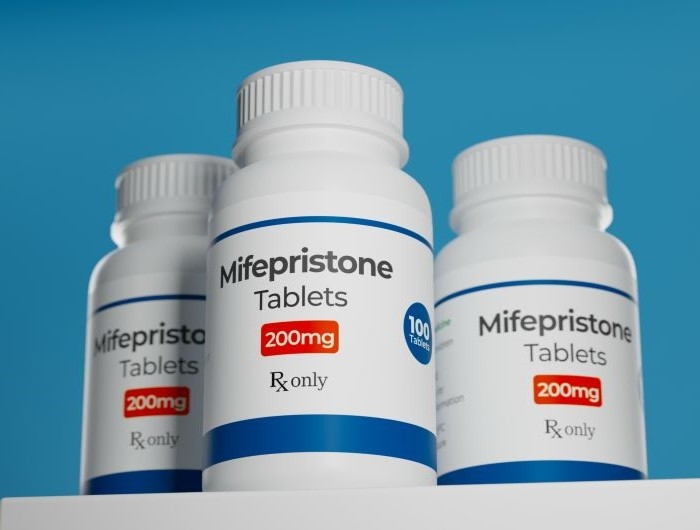Mifepristone: Supreme Court rules in favor of FDA

Carl - stock.adobe.com
A controversial lawsuit by antiabortion advocates to force the Food and Drug Administration to ban or restrict the use of the abortion pill mifepristone, used in more than half of the abortions in the United States, has been unanimously decided in favor of the FDA by the Supreme Court, citing the plaintiffs' lack of standing.
What is mifepristone?
Mifepristone is an FDA-approved drug that is ordinarily used in a regimen with another drug, misoprostol, to end an early pregnancy. Millions of women have effectively used mifepristone to terminate early pregnancies, and years of evidence and countless studies have demonstrated that the medication is safe and effective.
Key abortion drug studies retracted
Three studies that antiabortion plaintiffs have been using to argue that the abortion drug mifepristone is unsafe were retracted in early February by the medical journal that published them. Texas federal judge Matthew J. Kacsmaryk cited two of these studies in his 2023 ruling that mifepristone should be taken off the market. The Supreme Court heard FDA v. Alliance for Hippocratic Medicine in March and, on June 13, 2024, issued a decision in favor of the FDA.
These studies, which purported to show evidence that mifepristone is unsafe, have been discovered by their publisher or author to be so flawed or questionable that their conclusions are no longer reliable. The papers are essentially “unpublished,” which is a warning to other researchers not to trust the evidence in them.
The preponderance of well-conducted and vetted research shows that mifepristone is a safe alternative to surgical abortion, so this sudden development should provide one more reason for the Supreme Court not to agree with the antiabortion plaintiffs’ claims, which were already dubious.
The FDA drug reviews were thorough and evidence-based
The Center for Science in the Public Interest, together with Public Citizen, filed an amicus brief in January urging the Court to reject the plaintiffs’ case, arguing that to do otherwise would allow judges without scientific training to overrule FDA decisions that were based on the agency’s longstanding, evidence-heavy review process.
Retraction is uncommon in science, affecting only about 1 in 2,500 to 5,000 published papers, usually after long investigations. In the case of the three mifepristone papers, Sage, which publishes 1,100 other professional journals, was first alerted to serious problems by Chad Adkins of the South University School of Pharmacy in Savannah, Georgia, who was familiar with the long record of the drug’s safety.
Among the retracted studies, the most prominent in the plaintiffs’ case against mifepristone was published in 2021 in the journal Health Services Research and Managerial Epidemiology. The paper’s eight coauthors, all affiliated with antiabortion organizations, examined trends in the numbers of Medicaid-insured women with recent medication or surgical abortions who visited emergency rooms from 1999 to 2015.
Their conclusion boils down to this: The number of visits to emergency rooms by women who had recently undergone drug-induced abortions increased dramatically during this time period, evidence to the authors that mifepristone is not safe.
However, there are two big problems with this inference.
First, the authors didn’t (or couldn’t) explain exactly why the women with medication abortions visited emergency departments (ED).
“ED visits are not an indicator of abortion safety,” says Ushma Upadhyay of the University of California San Francisco. A medication abortion may result in more emergency department visits than a surgical abortion, she points out, because it typically occurs while a patient is at home without medical supervision. “This may contribute to increased concern about the symptoms, which may then lead people to visit an ED for a consultation. This consultation does not necessarily mean an adverse event.”
Second, the authors provided no evidence that the increase in emergency room activity reflected anything more than increasing Medicaid enrollment after the introduction of the Affordable Care Act and the growing preference for medication abortion during the period they studied.
Mifepristone was approved by the FDA in 2000 and grew to be used in more than 30 percent of abortions in the United States by 2014, the tail end of their study period. “What they find is exactly what you would expect to find when you expand coverage and expand care,” Adkins pointed out. Still, the authors reported that emergency room visits grew faster for the women who underwent medication rather than surgical abortions during the 14 years of the study, especially from 2013 to 2015. The reasons, the authors said, were “not readily apparent,” but might have been because medication abortion providers were unable or unskilled to handle complications, although why this was suddenly a much bigger problem during the final years of their study is puzzling.
Studies with better methodologies find mifepristone is safe
The Food and Drug Administration approved mifepristone based in part on U.S. clinical trials of the drug with 16,794 women, resulting in a complete abortion of 97.4 percent and complications such as persistent or heavy bleeding or “incomplete expulsion” in 2.6 percent of the patients.
More recently, a 2015 California study by Upadhyay and her colleagues tracked women insured with California’s version of Medicaid who visited emergency rooms within 6 weeks after an abortion. Unlike the study that was recently retracted, this one was able to determine the reasons for the visits by examining the billing records that contained complete information about the care provided to each patient.
Only five percent of patients receiving medication abortions experienced complications, almost all of them minor. One woman in 322 (0.3 percent) suffered a major complication, defined as a hospital admission, surgery, or blood transfusion. Among those who underwent a surgical abortion, 1 in 625 (0.2 percent) experienced a major complication. These rates are both acceptably low and similar enough that it is reasonable for a pregnant person to decide between them based on their needs and preferences.
This year, Upadhyay and her co-authors published a study of the safety of mifepristone prescribed over a videoconference or by text messaging during the pandemic without requiring an in-person visit with a healthcare professional. This study goes directly to whether patients should be permitted to self-administer mifepristone, the central medical issue in the Supreme Court case. Among 6,034 medication abortions, 97.7 percent were completed without complications, and just 1 woman in 400 (0.3 percent) experienced a serious adverse event. Although the researchers did not have complete results for one-quarter of the patients, various statistical models suggested their outcomes were similar to the others.
Antiabortion plaintiffs' research had 'fundamental problems'
After receiving Adkin’s critique of the studies, Sage retained two subject matter experts to conduct independent reviews of all three retracted papers. Both reviewers, according to Sage, identified “fundamental problems with the study design and methodology, unjustified or incorrect factual assumptions, material errors in the authors’ analysis of the data, and misleading presentations of the data that, in their opinions, demonstrate a lack of scientific rigor and invalidate the authors’ conclusions in whole or in part.”
With that damning assessment, Sage had no choice but to retract the papers. James Studnicki, the lead author of all three, blasted Sage’s decision as “completely unjustified” and “a blatant attempt to discredit excellent research which is incongruent with a preferred abortion narrative.”
While it’s good that Sage, almost a year after being alerted to the papers’ flaws, finally withdrew them, this doesn’t say much for the publisher’s quality control or the much-vaunted process of peer review. Nor does it look good for our legal system that a federal judge could rely, at least in part, on such deficient evidence to justify banning access to a widely used, safe, and effective medication.
Case decided in favor of FDA, mifepristone access preserved
On Thursday, June 13, 2024, the Supreme Court unanimously ruled in favor of the FDA in FDA v. Alliance for Hippocratic Medicine because the plaintiffs lack standing, or the legal right to sue on behalf of others. Mifepristone and the FDA's authority to make it accessible without an in-person doctor's visit remain legal. The case opinion, written by Justice Brett Kavanaugh, sums up the decision succinctly: “[C]itizens and doctors do not have standing to sue simply because others are allowed to engage in certain activities – at least without the plaintiffs demonstrating how they would be injured by the government’s alleged under-regulation of others.”
David Schardt has been writing about nutrition for the general public and for professionals for more than 30 years. In 1988, he helped to write and edit the landmark Surgeon General's Report on Nutrition and Health. His book Eating Leaner and Lighter, published by Warner Books, was recommended for sensible nutrition by the USDA's Food and Nutrition Information Center. He has been featured on numerous television and radio programs and is widely quoted in the print media, especially on the subject of dietary supplements. David has graduate degrees in nutrition and biochemistry.
Support CSPI today
As a nonprofit organization that takes no donations from industry or government, CSPI relies on the support of donors to continue our work in securing a safe, nutritious, and transparent food system. Every donation—no matter how small—helps CSPI continue improving food access, removing harmful additives, strengthening food safety, conducting and reviewing research, and reforming food labeling.
Please support CSPI today, and consider contributing monthly. Thank you.

